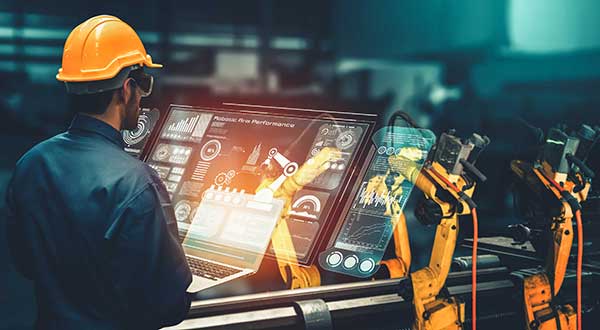Divining the future of manufacturing may be easier than you think.

To peek into the distant future, some key areas of the human environment must be well understood. These include: technology to produce products (including digital technology); supply chains; modern history and geopolitics; sociology; and the science of product development and material engineering.
Many articles, books, and speakers seem to view the process of manufacturing products as a given or even standardized thing. But, as we know, this is far from the case.
You can read a lot about smart manufacturing enabled by advanced automation, robotics, and digital solutions. This is where many organizations are right now. You can hear that the future will be a hyperconnected environment, data-driven and virtually captured in the fully digital universe, which some call the Industrial Metaverse. Some of these disruptions are happening; some are being piloted or just incubated.
However, I find most of these trends and solutions just an add-on to the ways products are actually produced.
Don’t get me wrong — recent decades have seen significant improvements in production processes that have led to leaner and improved production efficiency, less energy per unit produced, less waste, and improved sustainability. However, in most subindustries, from the perspective of basic principles, the products themselves haven’t changed significantly.
A great example is the automobile. Even if we see the shift from complex combustion engine-powered systems to electric vehicle drives, the rest of the car has remained essentially the same: four wheels with rubber pneumatics, glass windows, mechanical doors, a trunk, and the body. The design and mechanical principles of motorcycles, trains, planes, bicycles, and other machinery remain based on the way humans have always used them.
And it’s hard to see any significant disruptive invention that will change this any time soon. Perhaps the real-world emergence of some radical technology from the field of science fiction could do it — like levitating glass bubbles that would soundlessly zip us from Point A to Point B. We can always dream.
In truth, in the foreseeable future there’s not likely to be much change in the way people use physical things in their daily and business lives.
Of course, computerization and digitalization have wiped out some major products we depended on 20 years ago. For example, the common apps on your smartphone — maps, radios, various guides, communications instruments, the torch — used to all be separate physical objects. The businesses that make these products have been disrupted, and these tools are now produced in ways few imagined just a short time ago. However, this kind of development can only go so far: Humans still — and will — need physical objects for many areas of personal and industrial use.
Hyper-automation will be prominent in the production environment of the future. Its efficiency and process innovation is driven by AI-powered orchestration solutions that can oversee intelligent machines, fleets of industrial robots, and autonomous mobile robots.
At the factory level, the future will involve adding intelligent process automation enhanced with AI-powered tools like optical character recognition (OCR). Wrap the company and related supply chains in the digital fabric — suddenly, you’ve got a real cyberphysical environment.
Lots of you have probably heard it all before: The principles of Industry 4.0 and machine-to-machine collaboration — even chain-to-chain collaboration in an autonomous, self-managing, self-healing way. And self-threat detection and self-defense to counter cyberattacks, which are sure to keep rising as far as the eye can see.
Even if this future has promising aspects, it is definitely not enough from the perspective of staying competitive and sustainable. Which takes us get back to the start of this article: The ways products are produced, even when applying the latest inventions, has physical limits. The sky is the limit in terms of lean manufacturing. But then what?
One of the most significant disruptions in the way we produce things has been additive manufacturing, commonly represented by 3D printing technology. It can be recognized as a bridge between digital, physical objects, and material innovations. I’d even say that 3D printing technology was an absolute revolution regarding production technology and the physical characteristics of final products.
Unfortunately, material-type and production speed limitations make this great technology not suitable for mass production. It still can’t fully replace steel or aluminum products in most areas of heavy industry and heavy machinery.
If 3D printing has limited utility — and if most of the planet is more or less presently undergoing digital transformation — what could become a significant game changer in terms of production and competitive advantage?
Answer: Material engineering — researching and developing new materials that disrupt the way products are created, operated, serviced, and recycled.
The goal is not just to produce more effectively and sustainably, but to completely revamp production of the final products we have used for hundred years. By pushing the laws of physics and chemistry, we can revolutionize what raw materials are capable of.
The future of manufacturing goes beyond the triangle of people, processes, and technology. Serious challenges like reducing global dependency on rare minerals and oil must be addressed. The ability to develop and deploy new materials will be a key differentiator between leaders and followers.
On the national level, governments already realize that competitive advantage comes through advanced materials engineering. A great example is the United States’ National Strategy for Advanced Manufacturing. Published in October 2022, the report delineates strategic objectives and technical and program priorities, and makes recommendations on what should be achieved within a four-year time frame. The report’s Objective 1.4: Develop Innovative Materials and Processing Technologies, explicitly addresses critical materials.
According to the report, research should focus on identifying and integrating substitute materials and technologies to reduce or replace the use of critical materials in high-demand technologies. Design and manufacturing methods for critical components and products that can be reused, recycled, remanufactured, and repurposed must be developed as well.
The European Union also recognizes the importance of materials development and is supporting research and innovation in advanced materials and chemicals, including nanomaterials. For those who want to better understand European advanced materials strategies, I recommend the Materials 2030 Roadmap. Published in June 2022, it was built on the Materials 2030 Manifesto. I agree with those who say Europe must accelerate the development of new materials — which will in turn stimulate the development of new manufacturing technology and processes.
However, the overall goal must be not just to develop new materials that can be leveraged in the traditional ways. To meet resiliency and environmental goals, manufacturing process development must occur alongside the R&D of new materials and products.
The journey of material innovations from the laboratory to the shop floor is a key challenge. For maximum benefit, there should be close collaboration between material researchers, manufacturers and machine builders, product managers, even marketers.
For manufacturing organizations that do not have their own research and development capabilities, I recommend creating an ecosystem of materials start-ups and scale-ups. Such ecosystems should include universities that have applied research and innovation programs to help explore the possibilities of nanotechnology, responsive/intelligent materials, advanced composites, sustainable materials, and materials for additive manufacturing.
Digital transformation, advanced automation, data-driven operations, lean management, environmental sustainability, and supply chain resiliency – these are reshaping manufacturing as we know it. However, I believe the real revolution in the manufacturing environment will occur only after new materials trigger changes in production technology and production processes.
The rapid development of AI and quantum computing is a real material science accelerator. Manufacturing organizations, technology vendors, and machine builders must keep up with the research and help scientists turn inventions into industrial scalable applications. The time is now: Global competition and zero-pollution ambitions is pushing governments to accelerate investments in manufacturing and material research.

About the Author:
Jan Burian is an Associate Vice President, Head of IDC Manufacturing Insights EMEA.
Jan’s core research coverage includes Industry 4.0, IT/OT convergence strategies, Industrial Metaverse, sustainable manufacturing, and digital transformation across manufacturing subindustries.
Before joining IDC, Jan worked as a consultant at EY and Deloitte. He was a member of the Supply Chain and Operations Improvement teams and provided consulting services including performance improvement and enterprise digital transformation strategies.
In this episode, I sat down with Beejan Giga, Director | Partner and Caleb Emerson, Senior Results Manager at Carpedia International. We discussed the insights behind their recent Industry Today article, “Thinking Three Moves Ahead” and together we explored how manufacturers can plan more strategically, align with their suppliers, and build the operational discipline needed to support intentional, sustainable growth. It was a conversation packed with practical perspectives on navigating a fast-changing industry landscape.